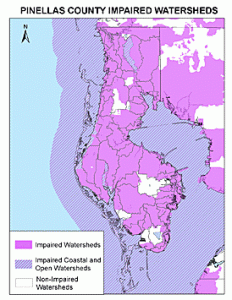Adults fear it and kids love it…it’s poop! Stool, waste, feces, dung, there are many ways to say it, but nobody ever really wants to talk about it. Everything that eats, poops, right? And all that poop has to go somewhere.
Fortunately for people, we have advanced technology and infrastructure to take our waste and treat it to a water quality standard that is good enough to be used for watering or to be dumped back into a local water body. What we often don’t consider is the waste that doesn’t get treated…pet waste! For the sake of this article we are going to focus on dog poo, but cats, horses and other pets contribute to the poop problem too.
The human population of Pinellas County is estimated at 949,827 according to 2015 census data. If we think about how many of those people own a dog or two or three, and the average-size dog produces about a half-pound of poop per day…that’s a lot of poop! According to Pinellas County Animal Services, there are approximately 132,000 licensed dogs in Pinellas County. That equates to about 66,000 pounds (~33 tons) of poop every day, the equivalent of filling 22 standard bathtubs full of dog poop, every single day.
Surveys have shown that 40% of people don’t pick up after their pets, so if we apply that to our number, that leaves roughly 26,400 pounds (~13 tons) of dog poop on the ground. Just one ounce or 1/16th of a pound of dog waste contains 23 million microorganisms of bacteria – two times the amount found in human waste. An average-size dog dropping contains 3 billion disease-causing, fecal coliform bacteria. When it rains, pet waste that is not properly disposed of is eventually washed into the nearest body of water. New lab tests have made it possible to trace bacteria found in water back to dog feces which allows Pinellas Watershed Management to better focus their efforts on the root cause of the problem, dogs or not.
Our local ponds and lakes can become impaired when this bacteria ends up in them. The Environmental Protection Agency (EPA) sets certain standards for water quality and when water bodies don’t meet those standards, they are considered impaired. In Pinellas County, Watershed Management has to work hard to fix impaired water bodies and they have a lot of work to do! The good news though, is that you can help. Pet owner or not, we can all help Watershed Management to keep fecal coliform levels at an acceptable level. Nobody wants to swim or fish in contaminated water, right?

What you can do to help:
- Pick up after your pet using a disposable bag you can place in a trashcan
- Encourage dog owners to properly dispose of their pet waste
- Take the “Scoop that Poop!” pledge through the Tampa Bay Estuary Program: http://bit.ly/PoopPledge
- Share this article with a friend, relative or neighbor
Thank you for helping to keep our precious water resources clean!
 0
0
